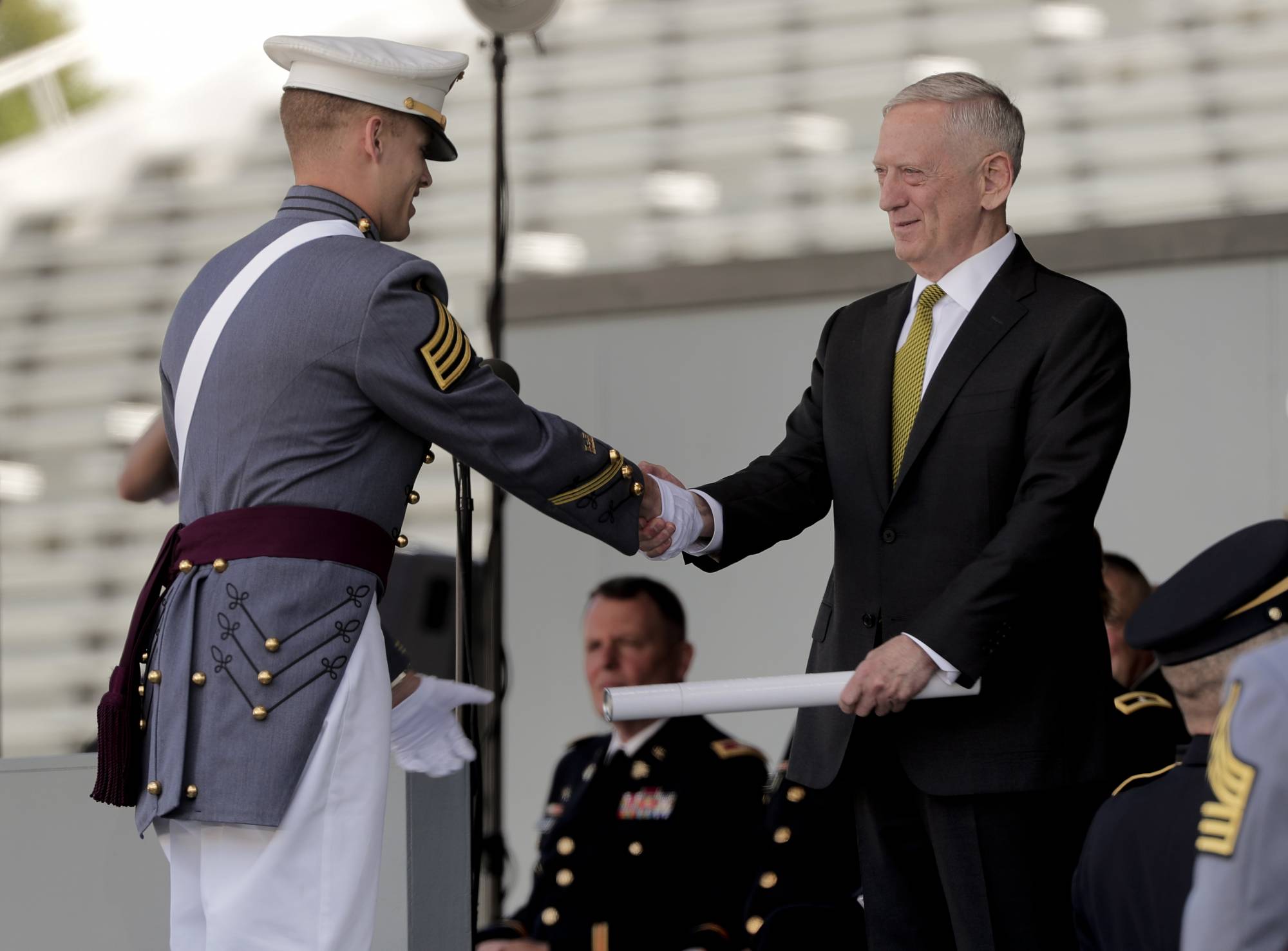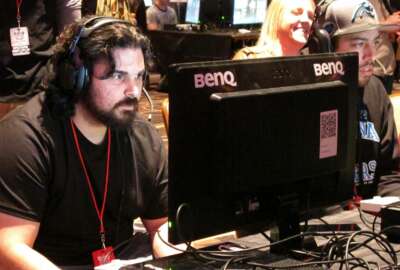
The Army tries a new tactic to fill its pipeline with future officers
Each generation brings new recruitment challenges for the Army. That's why the Army is constantly seeking fresh messages to deliver through its marketing channels.
Best listening experience is on Chrome, Firefox or Safari. Subscribe to Federal Drive’s daily audio interviews on Apple Podcasts or PodcastOne.
Each generation brings new recruitment challenges for the Army. That’s why the Army is constantly seeking fresh messages to deliver through its marketing channels. Maybe you remember, “be all you can be” or “the army of one.” Major General Alex Fink, the chief of Army enterprise marketing, spoke to the Federal Drive with Tom Temin about the latest recruiting challenge and the Army’s newest marketing campaign,
Interview transcript:
Tom Temin: And before we get into this latest campaign, I guess maybe people didn’t know that there was an enterprise marketing office for the army as something distinct from recruitment. So just tell us about what the office does first.
Alex Fink: You bet. Army enterprise marketing is a relatively new organization as it’s currently organized, it stood up about three years ago. Of course, the Army has had a functional marketing organization for many years. And you mentioned the older campaigns “be all you can be” an “army of one”. So clearly, they were involved in that. We took a fresh look at marketing, and the role of marketing in the Army, and really what you can do within the whole discipline in today’s environment. The last organization was designed and implemented before the invention of the iPhone, before social media as we know it today. And so about five or six years ago, the Army started looking at how do we basically reform the marketing organization to reflect both the media consumption habits of today’s youth, as well as the technology that’s available within the marketing sciences. And so this organization sort of evolved from that. Marketing organizations have been known as having really great creative folks, clever ads that you stick on TV, but today, it’s much more of a science. We have more data scientists on our team than we do creative folks, because of just the nature of how you do marketing in a digital environment. And so we moved it to Chicago, we wanted to be at a place where we had access to great talent. Chicago is one of the sort of the marketing destinations for those aspiring to be careers in marketing. So we do hire some number of civilians into our team and some marketing. So Chicago is good for that. But we also designed a new functional area within the Army. Many people may be familiar with public affairs officers or force managers.
Tom Temin: I know hundreds of them.
Alex Fink: Yeah, so you do. We actually developed a new functional area for marketing officers. So we started to grow that population as well. We’re around 50 officers that we’ve assessed over the last three years into this program. And so they also make up part of that staff. So we have a very healthy mix of civilian professionals, Army officers who are developing into marketing officers for us, and they’ll stay in this for their careers. So we happen to have an agency that’s located here in Chicago as well. So that plays a role also in having real crisp, clean engagement between us, the agency and the contracting vehicle that we use.
Tom Temin: Yeah, so no more 30 second spots on “My Three Sons” anymore. We’ve come a long way from that, I guess.
Alex Fink: Well, you know, yes, and no. We do have 30 second spots, but you might see them on Adult Swim, or Comedy Central, there’s an evolution to this, how we think about marketing, you have to look at this kind of over a period of years. And so we started out very data performance focused, putting messages in very precise places, really only targeting those folks who we thought, you know, we could convert to become a lead, and then eventually sign a contract, join the Army. As we’ve really developed that, what I call that data infrastructure, and the market research foundation that we have, and what we really understand youth at a much deeper level than we did three years ago. It does give us the ability to turn that dial a little bit and start having broader messages. And so I think in the future, you’ll see a little bit more of us across what we call the linear television. Even in some of the sports, we’ve kind of gotten away from a little bit. But for very specific reasons, those specific reasons have given us the flexibility to potentially turn that dial and be a little more broader in our messaging.
Tom Temin: We’re speaking with Major General Alex Fink, chief of Army enterprise marketing. This has really become a data-driven exercise, especially as recruitment becomes more challenging because of the changing population, changing attitudes. It sounds like you really need to get deep into very fine-grained data about prospects in order to be able to reach them effectively.
Alex Fink: That’s right, you know, everybody’s coming from a different place in terms of their background, their knowledge of the Army, their inclination to join. And it’s important that we understand where those folks are. And we have a segmentation that we use, we’ve got 11 different segments, we can model this thing down to the zip code level, there’s 53.8 million youth between the ages of 16 and 28 that we have within this model. And so we have a pretty good feel for you know, what’s important to them, their values, of course, we understand gender demographics, where they live, but we also understand their media consumption habits and what appeals to them. And that’s important in a modern marketing organization, particularly when, you know, we’ve got to live within a budget too, and so we can’t be everything to everybody. We’ve got to decide who we’re we’re gonna go after. And what’s the best thing for the Army.
Tom Temin: Sure, everybody has a smartphone, nobody has an offset wrench anymore, I guess. I guess I’m dating myself. But let’s get into this current campaign. You’re looking to make sure that you can bring in people that are officer bound. Tell us how this program, what it’s aimed at, and where it will play out.
Alex Fink: Sure. And so this really goes back a couple of years, we typically don’t just get an idea while we’re in the elevator in the morning and decided to create a campaign a few weeks later. These are things that are really informed with the needs of the Army, what we’re hearing from Army senior leadership. So this was started way back in March of 2020. Literally, we had our first meeting pre-lock down days at least, and what we needed to do to think about the officer corps, and when we think about that, we actually take a very long term view. An officer career, the officer path, the service is developing those folks is a much different way than necessarily our enlisted path to service. And we looked at the colonels and the general officers of 2050, that are going to be you know, choosing to go to college now, right? And what is America going to look like in 2050? What do we want our officers to look like? And I don’t mean that necessarily I mean, that in diversity, but in all aspects of diversity, not just how we traditionally think about it, and making sure that we have just the right folks at those senior levels that can ascend to the very senior levels of the army. And so that’s how we start and then we back into the, so what do we need to do now, in order to do that? And so that’s where the inspiration behind the campaign, then it’s all about okay, so how do we how do we attract those college bound youth? I’m happy to go into that as well.
Tom Temin: Right. But the objective is to attract college-bound youth to ROTC specifically?
Alex Fink: Yes, I would say it is a we think about that as far as a commissioning source, somewhat agnostic, because it really just supporting officers, no matter how you get to that route, but ROTC produces the most officers for the Army, followed by West Point and then a distant third and fourth would be OCS and direct commission. But ROTC has the lion’s share of the officers that we commissioned each year. And one of the challenges we have is the fact that youth just don’t understand the Army, and they’ve heard of ROTC. Maybe they had JROTC in their high school, but they don’t make a distinction between officer path to service versus enlisted path to service. We’re starting with this idea amongst youth is it’s a you can do Army or I can go to college. And what we’re trying to do is say that actually you can do it and right you can do the army through ROTC and go to college and still have the same sort of rich experience that everybody else has in college. But you also can come out of this you know, with a job, with executive level leadership opportunities, training, you know, an investment in you and so it’s really kind of a college plus idea.
Tom Temin: Major General Alex Fink is chief of Army enterprise marketing. Later this week, we’ll hear more from General Fink about the Army’s non-officer recruiting challenges.
Copyright © 2025 Federal News Network. All rights reserved. This website is not intended for users located within the European Economic Area.
Tom Temin is host of the Federal Drive and has been providing insight on federal technology and management issues for more than 30 years.
Follow @tteminWFED





